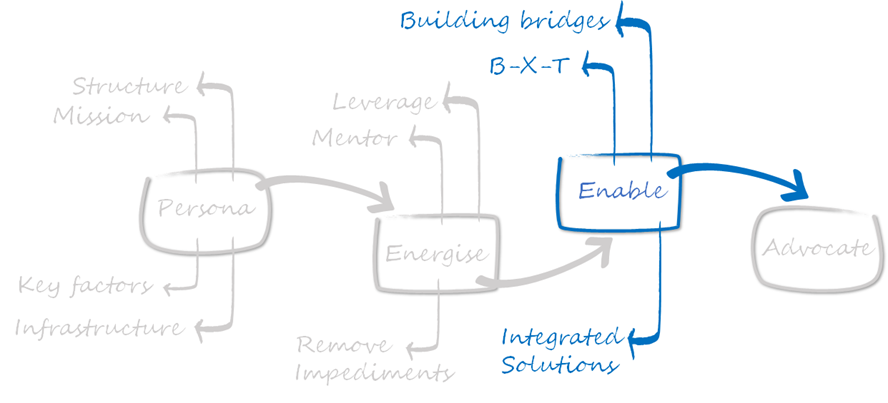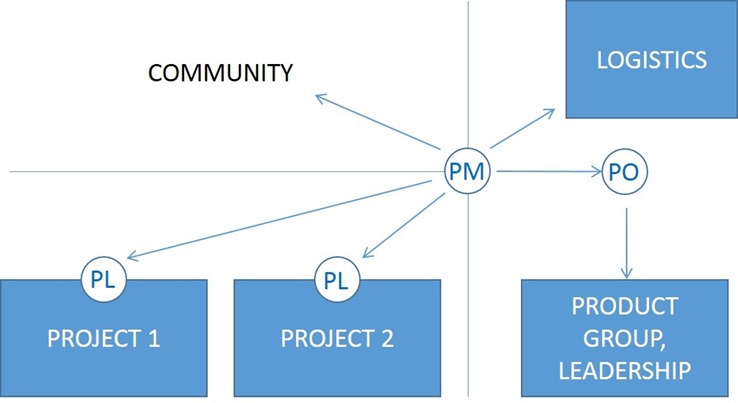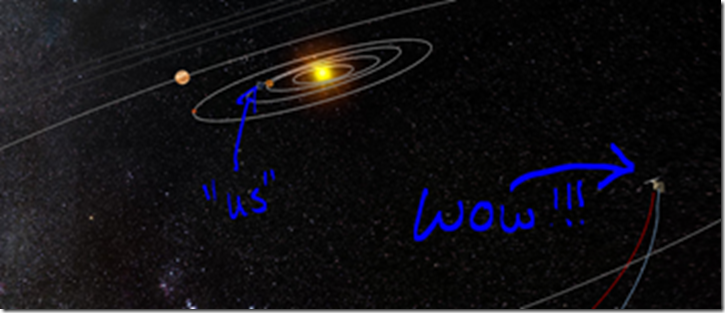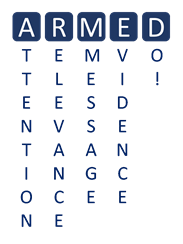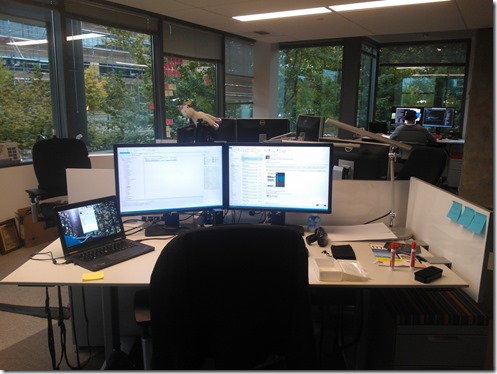Fun of PM.3 … Orchestrate and enable
After covering Persona and Energize in the Fun of PM.1 and Fun of PM.2 posts, it is time to focus on Enable. The concept of enabling the team has been mentioned as a side-effect in connection with leveraging and orchestrating resources, removal of impediments and leadership.
In this post we will focus explicitly on building bridges, B-X-T perspective, integrated solutions and end with a snapshot of a typical PM Day in Anisha Pindoria’s world.
The two affected areas on my wake-up image are highlighted”":
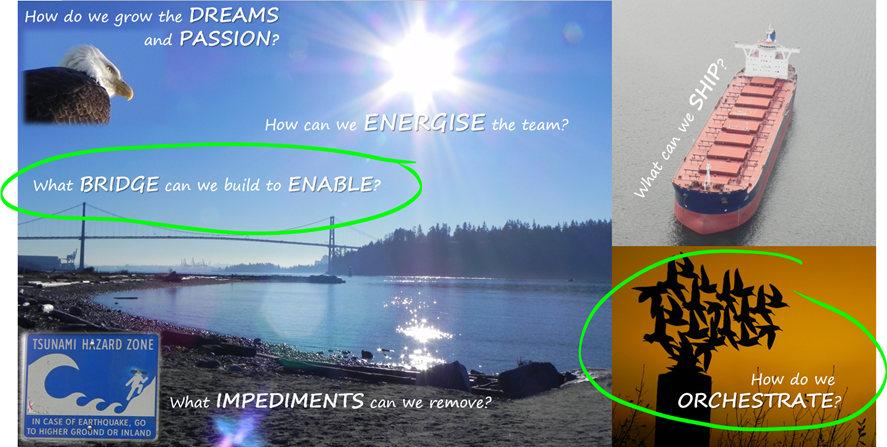
building bridges
As a PM with the Visual Studio ALM Rangers the responsibility of building bridges is continuous and strategic. The PM builds bridges with:
- Communities (users) to understand the “in-the-field” realities, balance demand with feasibility, and coordinate the communication between the project teams, stakeholders and the community.
- Product group teams to foster on-the-job (project) collaboration and sharing of user experience of applicable technologies.
- Product group leadership to ensure we select win-win projects valuable to both the community and Visual Studio ALM. See Triage of ideas … ∆ process changes for details on the triage of project ideas.
- Subject matter experts (SME) to ensure the project teams have the necessary expertise as needed.
- Other PMs to share learnings, align processes and foster peer mentorship as discussed in Fun of PM.2.
As shown above the PM plays a pivotal role in projects to maintain collaboration across the bridges, to shield and protect each end-point from unnecessary noise and communication overload, and to coordinate and contribute to any emergency (fire-fight). The fire-fights typically involve the PM assuming different roles, for example developer, tester, contributor, reviewer or end-user, to encourage and support project teams to ship on time, every time.
It is better to have one person working with you than three people working for you.- Dwight D. Eisenhower
Another important bridge to nurture is the one between the project team and product owner (PO). Within the ALM Rangers context, the PO is often a principal/senior PM, with a very limited bandwidth. To manage the PO bandwidth and expectations is another PM responsibility that can be both challenging and rewarding. Watching a PO engage, share their excitement and encouragement with the team can be a phenomenal experience. Supporting a PO, reducing involvement, ownership and responsibility tax, and establishing a trust is challenging, but bears a lot of fruit down the line.
B-X-T
The program manager enables the B-X-T perspectives by ensuring that every solution delivers business value, a great user experience, and that it is technically sound.
business value
In our context, we continuously reflect on and innovate our triage process (Triage of ideas … ∆ process changes) to ensure that we commit to win-win solutions, in terms of business value to the community, ALM Rangers, and the core product team. Remember that our mission is to “provide professional guidance, practical experience and gap-filling solutions to the ALM community”. A gap perceived by the community, may be an exciting adventure for the Rangers, but if it is an intentional gap, or if it will be filled with an imminent release of the core product, the business value will be reduced.
I am easily satisfied with the very best - Winston Churchill
The PM should continuously ask: WHAT are we building, WHY are we building it, and what is the VALUE today and tomorrow?
great user experience
A PM needs to have a collection of persona or role hats. A solution idea and solution in the making, should be constantly reviewed from a user’s perspective.
The PM should continuously ask: How easy and pleasurable is it to use?
The PM should continuously get candid user feedback, analyse and guide the team to innovate and improve the experience. Remember to loop back to gathering user feedback!
technically sound
Using quality essentials principles and continuously aligning and raising the quality bar, we ensure that we use the right tools, for the right job and deliver a technically sound solution that is not only functional, but also maintainable.
See let us talk about “Quality Bars”, raising the Quality Bar for Tooling and raising the Quality Bar for Documentation for details.
great example
The rosetta rendezvous with a comet project is truly inspirational.
- After 10 years of flight and 6,205,617,163km travel, the probe responded and is fully operational … technically sound!
- It is delivering phenomenal images and data from deep space, which are easy and a pleasure to monitor … great user experience!
- It delivers phenomenal business value to the scientists and humanity … unimaginable business value!
integrated solutions
This is a topic which we will hopefully initiate and engage in a lot of discussions. It is also one with a number of possible themes, but I will focus on my personal interpretation in this post.
It always seems impossible until its done - Nelson Mandela
As a PM we are the perfect champion to orchestrate, leverage and enable teams to work “as one”, encourage solutions that deliver the right features, support efficient and continuously improving processes. In fact I am tempted to use practice, as process is a very overloaded and heavy term.
The PM needs to understand the customer expectations, collaborate with other PMs to share, improve and improve practices continuously, and measure effort and cost.
In fact, the Certificate in DevOps, which is an initiative we are helping the University of Washington to create and deliver, is a great start into the world of the continuous software improvement and delivery mindset.
Let’s end by with a useful memory-hook for key concepts when selling, designing and presentation an integrated solution idea:
Now I will hand-over to my colleague Anisha Pindoria to give us a snapshot of a day in her PM adventure.
a day in Anisha’s PM day
In Anisha’s own words:
I have been in this role for 5 weeks now, but it feels like I have been in this role for months, with everyday being so different! I know I still have lots to learn, and a high ladder to climb but I am loving the role so far.
As I am still getting my hands on the ropes, my typical day starts at around 8ish, sometimes earlier depending on how quickly the bus gets me to the office and if I have any earlier meetings. As Willy has mentioned in his previous blog posts, the Rangers are literally a worldwide community, so there are times when meetings are a little earlier to cater for those across the globe. Originally an active Ranger based in the UK, I can definitely understand the time differences. I do the usual in the mornings – checking emails and checking my outlook calendar again (I usually check the day before and remind myself the next day).
Usually there are stand-up meetings in the mornings that take place anytime from 9am-12pm. I like to sit in all of the Rangers projects at the moment, so that I can climb the learning rope quicker, and be a back-up ruck master if needs be.
The afternoon usually consists of meetings either in building 18 or over Lync. The meetings range from 1:1’s to team meetings to strategic project meetings to coffee chats and meeting new people.
As I am based in Redmond, and sit opposite my manager Claude, and besides Sam Guckenheimer, I am occasionally part of adhoc meetings and discussions, which are great!
During the times in-between, I am working on Ranger projects that I am involved in, and working in operations alongside Willy. So what do I mean by ‘operations’? Well, it is essentially working with the Rangers infrastructure, and keeping the operational ecosystem running smoothly, efficiently, and looking for ways to improve current processes. I also spend time talking to Willy over Lync to get a better understanding of the day-to-day runnings, the world of PM’ing, and discussing current/future projects. I am hoping to take on more projects, as I climb that rope higher.
My day in the office typically ends around 4ish, where I run to catch the bus, and start on dinner, and occasionally checking for any new emails in-between. Sometimes, I do carry on working if there are certain deadlines creeping up, and will then try and aim for a finish at 6ish where I run to catch the shorter bus ride to catch a car ride home with my husband.
I am loving the role so far, as every day is so different, and this role is so unique.
… call to action!
? Thoughts? Candid feedback?
! We need your feedback and questions to fuel these discussions and help us improve our mentoring program.
Next time we will look at the advocate bubble and review two weeks of pedantic timesheet data, to get an idea of exactly what we typically invest our time in.
special thanks
Special thanks to Anisha Pindoria and Rui Melo, who help me improve these posts as part of our peer mentorship.

